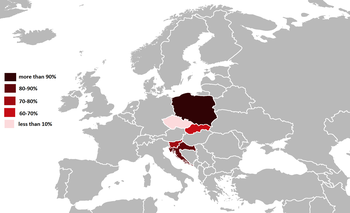Catholic Slavs
 Catholic Slavic countries by percentage (Poland, Czech Republic, Slovakia, Slovenia and Croatia)[citation needed] | |
| Total population | |
|---|---|
| c. 60,500,000 (2018 est.)[citation needed] | |
| Regions with significant populations | |
| Central Europe and Southeastern Europe | |
| Languages | |
| West Slavic South Slavic [citation needed] | |
| Religion | |
| Roman Catholicism | |
| Related ethnic groups | |
| Other Slavs |
Catholic Slavs and Slavic Catholic are terms used for the historically and/or predominantly Catholic Slavic ethnic groups and nations and for the history of Catholicism among the Slavic peoples. The Catholic Slavic nations include all West Slavs (Poles, Czechs and Slovaks and all their sub-ethnicities ex. Kashubs, Silesians, Sorbs) as well as the westernmost South Slavs (Slovenes and Croats).[1][not in citation given]
History[edit]
Middle Ages[edit]
Grand Duke Kazimierz IV of Lithuania and Poland (r. 1440–92) initiated the Catholicization of Kiev (which was Orthodox) early in his reign.[2][clarification needed]
Early modern period[edit]
The Union of Brest (1596) saw the official establishment of the Uniate Church (Eastern in custom and ritual but subscribing to Catholic dogma and submission to the Pope as head of the Church) in the Grand Duchy of Lithuania.[2][clarification needed]
The Habsburg Monarchy launched a programme of re-Catholicization in Bohemia and Moravia in the 1620s.[3][clarification needed] The Serbian Orthodox Eparchy of Marča became Uniate in 1611, although it was part of a conflict between local Catholic and Orthodox clergy over the century.[4][clarification needed]
Modern states[edit]
Modern countries in which historically Catholic Slavs formed a majority or otherwise such nation states include:
See also[edit]
References[edit]
- ↑ Slavica Jakelic (23 May 2016). Collectivistic Religions: Religion, Choice, and Identity in Late Modernity. Routledge. pp. 101–. ISBN 978-1-317-16420-3. Search this book on

- ↑ 2.0 2.1 Cooper 2003, p. 227.
- ↑ Josef V. Polišenský (1971). The Thirty Years War. University of California Press. pp. 141–. ISBN 978-0-520-01868-6. Search this book on

- ↑ Zlatko Kudelić (2007). Marčanska biskupija: Habsburgovci, pravoslavlje i crkvena unija u Hrvatsko-slavonskoj vojnoj krajini (1611. - 1755). Hrvatski Inst. za Povijest. ISBN 978-953-6324-62-0. Search this book on

- ↑ Marty, Martin E. (1997). Religion, Ethnicity, and Self-Identity: Nations in Turmoil. University Press of New England. ISBN 0-87451-815-6.
[...] the three ethnoreligious groups that have played the roles of the protagonists in the bloody tragedy that has unfolded in the former Yugoslavia: the Christian Orthodox Serbs, the Roman Catholic Croats, and the Muslim Slavs of Bosnia.
Search this book on
- ↑ Richard Felix Staar, Communist regimes in Eastern Europe, Issue 269, p. 90
- ↑ "Niektóre wyznania religijne w Polsce w 2017 r. (Selected religious denominations in Poland in 2017)" (PDF). Mały Rocznik Statystyczny Polski 2018 (Concise Statistical Yearbook of Poland 2018). Concise Statistical Yearbook of Poland = Mały Rocznik Statystyczny Polski (in Polish and English). Warszawa: Główny Urząd Statystyczny. 2018. pp. 114–115. ISSN 1640-3630.CS1 maint: Unrecognized language (link) Search this book on

- ↑ "Table 14 Population by religion" (PDF). Statistical Office of the SR. 2011. Retrieved Jun 8, 2012.
- ↑ "Eurobarometer 90.4 (December 2018): Attitudes of Europeans towards Biodiversity, Awareness and Perceptions of EU customs, and Perceptions of Antisemitism", Special Eurobarometer, European Union: European Commission, 2019, retrieved 9 August 2019 – via GESIS
Sources[edit]
- Cooper, Henry R. (2003). Slavic Scriptures: The Formation of the Church Slavonic Version of the Holy Bible. Fairleigh Dickinson Univ Press. pp. 227–. ISBN 978-0-8386-3972-6. Search this book on

This article "Catholic Slavs" is from Wikipedia. The list of its authors can be seen in its historical and/or the page Edithistory:Catholic Slavs. Articles copied from Draft Namespace on Wikipedia could be seen on the Draft Namespace of Wikipedia and not main one.
